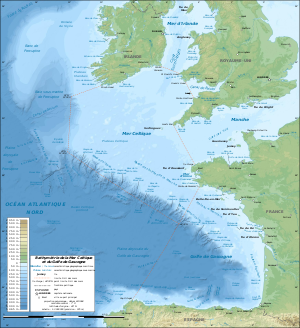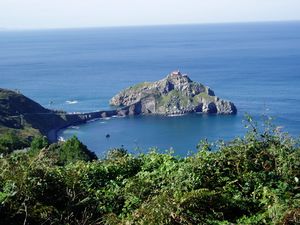خليج بسكاي

خليج بسكاي Bay of Biscay امتداد للمحيط الأطلسي، على الساحل الغربي لأوروبا. ويقع إلى الغرب من فرنسا، وشمالي أسبانيا. ويبلغ طول شاطئ خليج بسكاي حوالي 640 كم. ويبلغ عرض الخليج عبر أوسع نقاطه 480 كم.
ويأخذ خليج بسكاي اسمه من الباسك، وهم قوم يعيشون على امتداد صخور الشاطئ الأسباني. والمدن الرئيسية على الجانب الأسباني من الخليج تشمل بلباو وسان سباستيان وگيون وسانتاندر.
ومصبات أنهار أدور، وشارنت گارون، واللوار تقع على الجانب الفرنسي. والموانئ الفرنسية على الخليج ومداخله تشمل بايون، وبوردو، وبرست، ونانت، وروتفورت.
ويتميز خليج بسكاي برياحه العاتية، وأمواجه العاصفة. وفي عام 1588 بعثرت عاصفة في خليج بسكاي السفن الخشبية للأسطول الأسباني الأرمادا عندما انطلقت لمهاجمة إنجلترا. وقد أطلق قدماء الرومان على الخليج اسم بحر كانتابريا.
. . . . . . . . . . . . . . . . . . . . . . . . . . . . . . . . . . . . . . . . . . . . . . . . . . . . . . . . . . . . . . . . . . . . . . . . . . . . . . . . . . . . . . . . . . . . . . . . . . . . . . . . . . . . . . . . . . . . . . . . . . . . . . . . . . . . . . . . . . . . . . . . . . . . . . . . . . . . . . . . . . . . . . . .
التاريخ
The Bay of Biscay has been the site of many famous naval engagements over the centuries. In 1592 the Spanish defeated an English fleet during the eponymous معركة خليج بسكاي.
The Bay of Biscay has been the site of many famous naval engagements over the centuries. In 1592 the Spanish defeated an English fleet during the eponymous معركة خليج بسكاي. The Biscay campaign of June 1795 consisted of a series of manoeuvres and two battles fought between the British Channel Fleet and the French Atlantic Fleet off the southern coast of Brittany during the second year of the French Revolutionary Wars. يوإسإس Californian sank here after striking a naval mine on 22 June 1918.[1] In 1920 إسإس Afrique sank after losing power and drifting into a reef in a storm with the loss of 575 lives. On 28 December 1943, the Battle of the Bay of Biscay was fought between إتشإمإس Glasgow and إتشإمإس Enterprise and a group of German destroyers as part of Operation Stonewall during World War II. U-667 sank on 25 August 1944 in position 46°00′N 01°30′W / 46.000°N 1.500°W, when she struck a mine. All hands were lost.
On 12 April 1970, Soviet submarine K-8 sank in the Bay of Biscay due to a fire that crippled the submarine's nuclear reactors. An attempt to save the sub failed, resulting in the death of forty sailors and the loss of four nuclear torpedoes. Due to the great depth (15,000 feet or 4,600 metres), no salvage operation was attempted.
الحياة البرية
الثدييات البحرية
The car ferries from Gijón to Nantes/Saint-Nazaire, Portsmouth to Bilbao and from Plymouth, Portsmouth and Poole to Santander provide one of the most convenient ways to see cetaceans in European waters. Often specialist groups take the ferries to hear more information. Volunteers and employees of ORCA regularly observe and monitor cetacean activity from the bridge of the ships on Brittany Ferries' Portsmouth to Santander route. Many species of whales and dolphins can be seen in this area. Most importantly, it is one of the few places in the world where the beaked whales, such as the Cuvier's beaked whale, have been observed relatively frequently. Biscay Dolphin Research monitored cetacean activity from the P&O Ferries cruiseferry Pride of Bilbao, on voyages from Portsmouth to Bilbao.
North Atlantic right whales, one of the most endangered whales, once came to the bay for feeding and probably for calving as well, but whaling activities by Basque people almost wiped them out sometime prior to 1850s. The eastern population of this species are considered to be almost extinct, and there has been no record of right whales in the Bay of Biscay except for a pair in 1977 (possibly a mother and calf) at 43°00′N 10°30′W / 43.000°N 10.500°W,[2] and another pair in June 1980. Other records in the late 20th century include one off Galicia at 43°00′N 10°30′W / 43.000°N 10.500°W in September 1977 reported by a whaling company and another one seen off the Iberian Peninsula.
The best areas to see the larger cetaceans are in the deep waters beyond the continental shelf, particularly over the Santander Canyon and Torrelavega Canyon in the south of the Bay.
The alga Colpomenia peregrina was introduced and first noticed in 1906 by oyster fishermen in the Bay of Biscay.
Grammatostomias flagellibarba (scaleless dragonfish) are native to these waters.[3]
انظر أيضاً
المصادر
- ^ "USS Californian (1918–1918)". History.navy.mil. Archived from the original on 2004-12-24. Retrieved 2015-07-17.
{{cite web}}: Unknown parameter|dead-url=ignored (|url-status=suggested) (help) - ^ Reeves, R.R.; Mitchell, E. (1986). "American pelagic whaling for right whales in the North Atlantic" (PDF). Report of the International Whaling Commission (Special Issue 10): 221–254. Retrieved 2013-10-09.
{{cite journal}}: Unknown parameter|lastauthoramp=ignored (|name-list-style=suggested) (help)[dead link] - ^ "Grammatostomias flagellibarba". FishBase. 2016. Archived from the original on 2015-08-25.
{{cite web}}: Unknown parameter|deadurl=ignored (|url-status=suggested) (help); Unknown parameter|editors=ignored (|editor=suggested) (help)
وصلات خارجية
- . . 1914.
- CS1 errors: unsupported parameter
- Articles with dead external links from October 2016
- Articles with hatnote templates targeting a nonexistent page
- Wikipedia articles incorporating citation to the NSRW
- Wikipedia articles incorporating citation to the NSRW with an wstitle parameter
- خليج بسكاي
- خلجان فرنسا
- خلجان اسبانيا
- خلجان المحيط الأطلنطي
- اسبانيا الخضراء
- Shipping Forecast areas
- حدود اسبانيا-فرنسا
- تضاريس أكيتان الجديدة
- تضاريس بريتاني
- تضاريس بلاد اللوار


